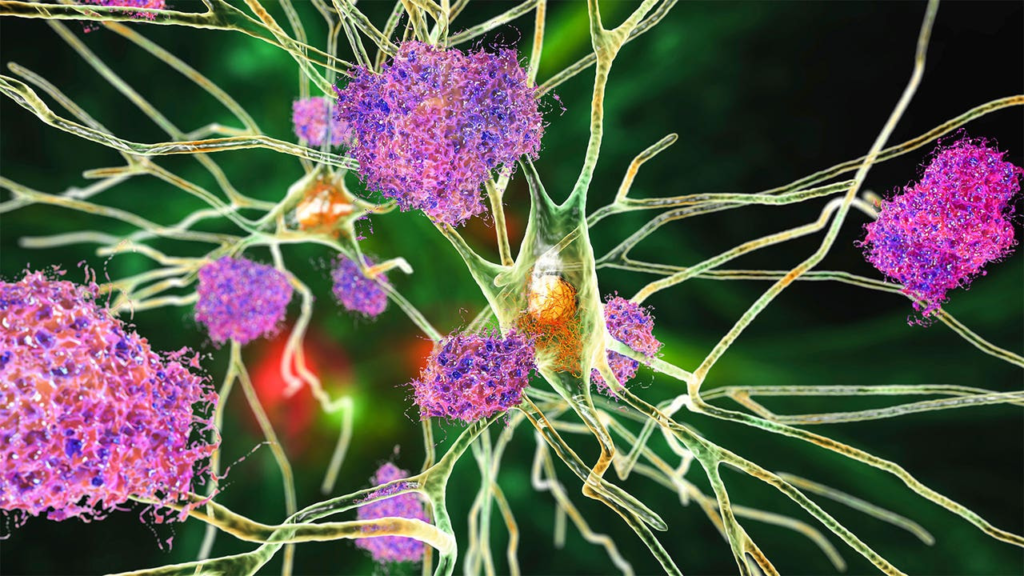— Alzheimer’s may be driven by multicellular communities, analysis suggests
by Judy George, Deputy Managing Editor, MedPage Today
September 3, 2024

Key Takeaways
Two distinct pathways of brain aging emerged in a cellular analysis of post-mortem brain tissue.
One trajectory led to Alzheimer’s disease, the other to an alternative brain aging pathway.
Cellular communities, not singular cell subpopulations, may need to be modulated to preserve cognitive function.
Two trajectories of brain aging were identified in a cellular analysis of post-mortem brain tissue: one leading to Alzheimer’s disease, the other to an alternative brain aging pathway.
The study involved participants in the Religious Order Study and the Rush Memory and Aging Project (ROSMAP), two long-term studies of cognitive aging with prospectively collected brains. Individuals with both Alzheimer’s disease and with non-Alzheimer’s brain aging were included.
A cell atlas of 1.65 million nuclei sampled from the dorsolateral prefrontal cortex of 437 ROSMAP participants showed specific glial and neuronal subpopulations were associated with Alzheimer-related traits, reported Philip De Jager, MD, PhD, of Columbia University Irving Medical Center in New York City, and co-authors in Natureopens in a new tab or window.
To model the dynamics of cellular environment, the researchers developed an algorithm called BEYOND to identify trajectories of brain aging based on changes in participants’ cellular communities.
While participants on the Alzheimer’s trajectory had increasing levels of amyloid and tau and accelerated cognitive impairment, alternative brain aging participants had a low and constant amyloid burden, limited tau pathology, and varying rates of cognitive decline.
In the Alzheimer’s pathway, two distinct microglial subpopulations emerged, both linked to altered lipid metabolism — one that appeared to drive amyloid-beta proteinopathy, and another that appeared to mediate the effect of amyloid-beta on tau proteinopathy. An astrocyte subpopulation that mediated the effect of tau on cognitive decline also was seen.
“We uncovered at least two distinct trajectories of brain aging, one of which leads to Alzheimer’s disease,” De Jager told MedPage Today. “This is consistent with the heterogeneity seen among the older population and is a critical insight, which will guide therapeutic development for Alzheimer’s disease and for the non-Alzheimer’s disease trajectory that we don’t understand at this time.”
The findings highlight that Alzheimer’s involves many cells and interactions, De Jager noted. Changes in glial subtypes appear to drive these trajectories but all cell types participate, he observed. “Cellular communities are proposed to be the target for therapeutic development,” he said.
This insight could lead to biomarkers that might help resolve whether a patient has remained at a healthy baseline, has entered the Alzheimer’s trajectory, or has entered a trajectory towards alternative brain aging, he added.
Previous brain sample analyses have provided data about the cells involved in Alzheimer’s disease, but resolving the sequence of changes in cell populations and distinguishing them from ones associated with brain aging has been challenging, the researchers noted.
“Past studies have analyzed brain samples as a whole and they lose all cellular detail,” De Jager said. “We now have tools to look at the brain in finer resolution, at the level of individual cells. When we couple this with detailed information on the cognitive state of brain donors before death, we can reconstruct trajectories of brain aging from the earliest stages of the disease.”
The study involved 437 ROSMAPopens in a new tab or window participants without known dementia at enrollment who had annual clinical evaluations and agreed in advance to brain donation at death.
The average age of death was 89.1 and 67.3% of participants were women. Most (62.4%) fulfilled a pathological diagnosis of Alzheimer’s disease; 36.3% received a diagnosis of Alzheimer’s dementia; and 26% had mild cognitive impairment when they died.
To identify cell subpopulations associated with Alzheimer’s disease, the researchers evaluated three traits — amyloid burden, tau burden, and participants’ rate of cognitive decline from annual testing. Findings were validated in a ROSMAP replication sample.
The study highlights that Alzheimer’s is a disease of the whole brain environment, the researchers observed. Cellular communities, not singular cell subpopulations, may need to be modulated to restore homeostasis and preserve cognitive function, they noted.
“Our structural equation modeling implicates specific glial subtypes and molecular processes and positions them along different stages of the long path to Alzheimer’s disease, which starts with the accumulation of amyloid, then the accumulation of tau pathology, and finally cognitive decline,” De Jager said.
Both the associations and trajectories seen in the study need to be replicated with single nucleus-derived data since the replication was performed using inferred frequencies, he noted.
“We need to understand the cellular interactions that are leading to these changes in cellular populations, to identify candidate proteins and pathways for therapeutic development,” he added.
“We also need to transition our trajectories derived from brain tissue to biofluids — blood or cerebrospinal fluid — that can be sampled in living individuals,” he said.
Judy George covers neurology and neuroscience news for MedPage Today, writing about brain aging, Alzheimer’s, dementia, MS, rare diseases, epilepsy, autism, headache, stroke, Parkinson’s, ALS, concussion, CTE, sleep, pain, and more. Follow
Disclosures
This work was supported by the National Institute on Aging and others.
De Jager reported no conflicts of interest. One co-author reported relationships with Celsius Therapeutics, Immunitas Therapeutics, Syros Pharmaceuticals, Neogene Therapeutics, Asimov, Thermo Fisher Scientific, and Genentech.
Primary Source
Nature
Source Reference: opens in a new tab or windowGreen GS, et al “Cellular communities reveal trajectories of brain aging and Alzheimer’s disease” Nature 2024; DOI: 10.1038/s41586-024-07871-6.

Leave a Reply